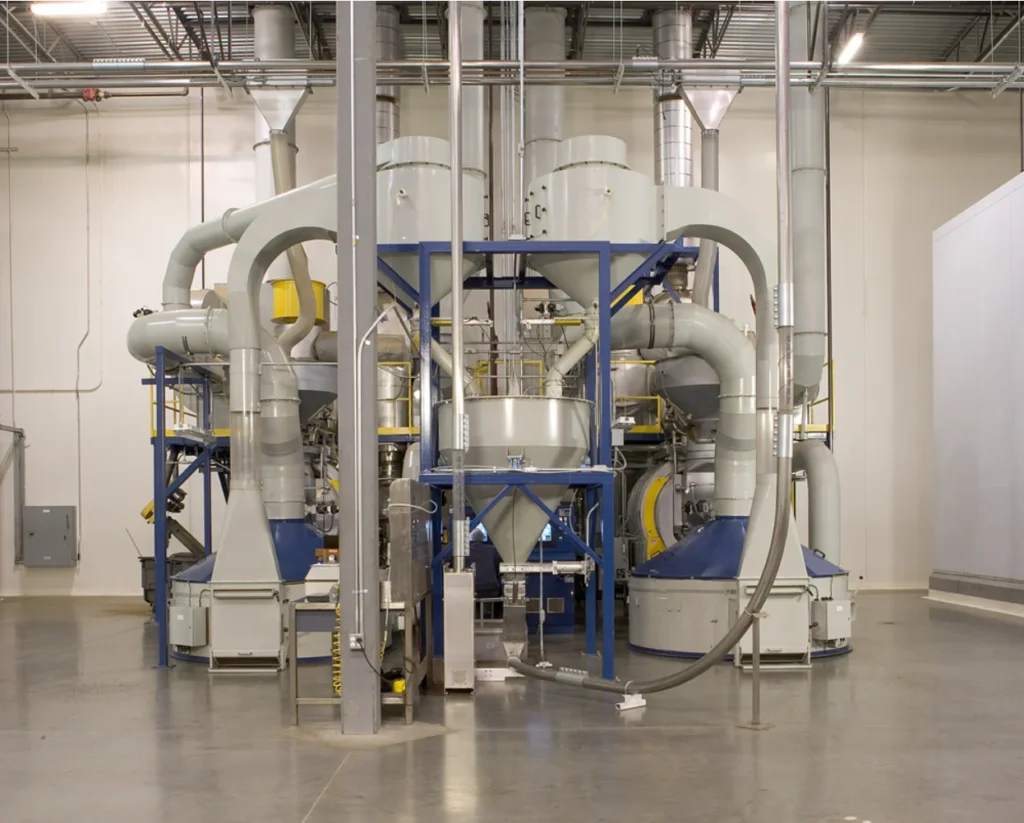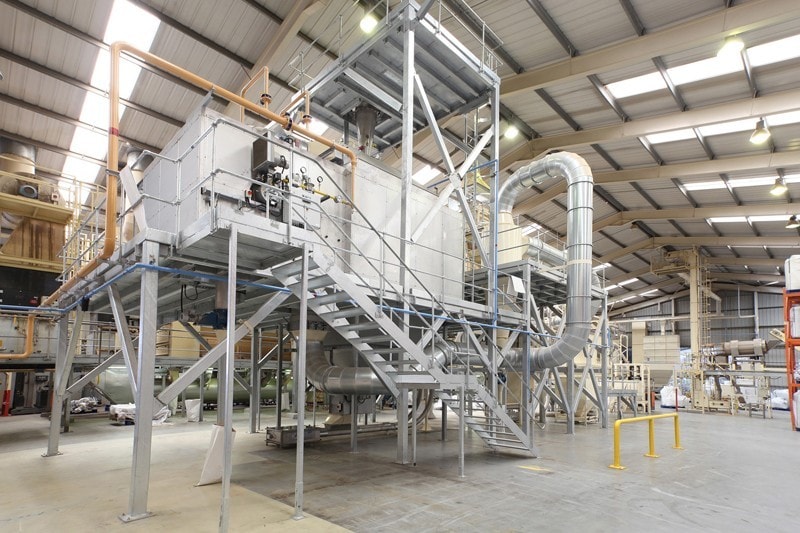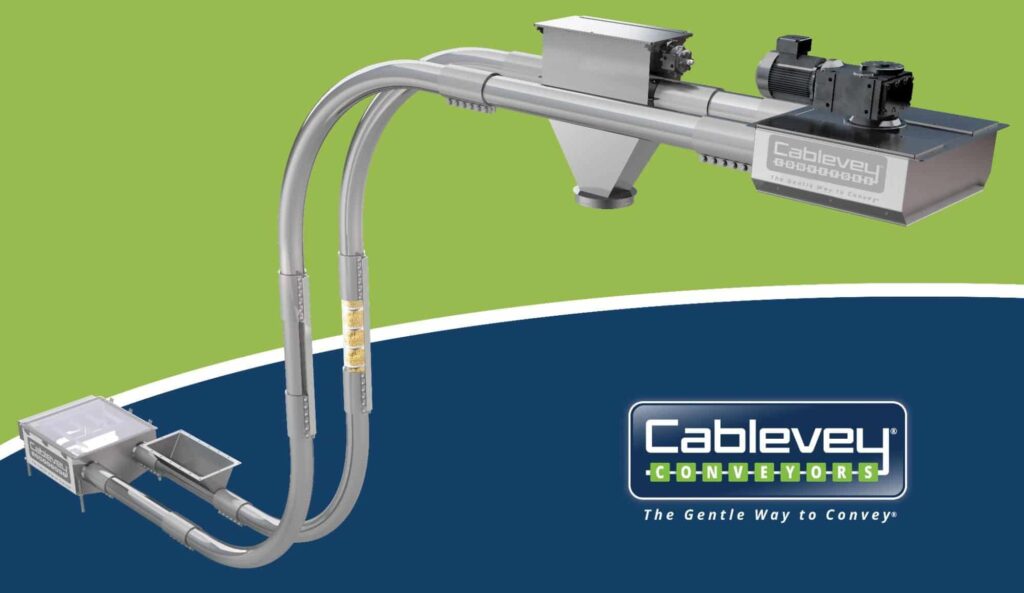In the intricate dance of a modern food processing plant, conveyors take center stage, seamlessly choreographing the movement of materials with efficiency and precision. But. with so many options, you surely wonder what type of conveyors are best suited for food processing.
What Type of Conveyors Are Best Suited for Food Processing?
Conveyors best suited for food processing include belt conveyors, bucket elevators, pneumatic conveyors, tubular chain conveyors, and specialized options like tubular cable and disc conveyors. The choice depends on factors like material fragility, volume, and specific processing needs.
Explore Different Types of Industrial Conveyor Systems
It is hard to imagine a food processing plant – or indeed any other kind of industrial facility – without automated conveyor systems. They are an essential part of most automated production processes, as they provide a quick and efficient way to move materials from one point to another.
Numerous conveyor options are accessible in the market, each presenting its own set of pros and cons. Selecting the most suitable conveyor for a food processing application requires careful consideration of the unique requirements of the facility and the nature of the materials being transported. So, let’s explore some of the most common types of conveyors used in food processing and discuss their key features, including those specifically designed for manufacturing conveyor systems:
- Belt conveyor,
- Bucket elevator,
- Pneumatic conveyor,
- Tubular chain conveyor,
- Cable and disc conveyor.
It would be irresponsible of us to suggest that one of these is unequivocally the best type of conveyor for all food processing applications – as, with most things in engineering, it depends on the specific circumstances. However, we can provide a general overview of each type of conveyor to help you choose the one best suited to your needs.

Conveyor Belt System Features Hygienic Design and Maintenance
Named for its design, belt conveyors consist of an unbroken loop of belts circulating around two or more pulleys. Usually constructed from PVC or other materials meeting food-grade standards, the belt is upheld by either a slider bed or roller bed.
The design not only facilitates efficient material movement but also emphasizes hygiene, making it crucial for industries with stringent cleanliness requirements. Cleaning conveyor belts is a routine task to maintain high standards of cleanliness. For optimal results, industries often turn to reputable belt conveyor manufacturers who specialize in producing systems that prioritize both functionality and ease of maintenance. Explore the pros and cons of these conveyor technologies:
Pros:
- Some of the most versatile conveyors on the market, as they can be used to transport a wide variety of products, both packaged and unpackaged.
- Particularly well-suited to applications where the conveyed material is fragile, as there is no risk of breakage or spillage.
Cons:
- Not suitable for high inclines or vertical conveying, meaning they are not ideal for limited-space applications.
- Cannot be used for wet or sticky products, as they will adhere to the belt and cause problems further down the line.
- Even though enclosed belt conveyors exist, they are not recommended for food processing applications as there is still a risk of product contamination.
Bucket Elevators Prevent Product Damage
Bucket conveyors, commonly referred to as bucket elevators, comprise a sequence of buckets affixed to a belt or chain. These buckets are conveyed either upward or downward along an inclined or vertical conveyor shaft. Here are the pros and cons you should consider:
Pros:
- Reduces product damage or spillage, as the buckets gently scoop up the product and deposit it without too much force.
- Low driving power, meaning they are relatively energy-efficient.
- Convenient for smaller facilities, as they mostly transport products vertically.
Cons:
- Incredibly difficult to clean and maintain. Not only will this lead to excessive downtime, but it also increases the risk of product contamination and cross-contamination.
Pneumatic Conveyor Uses Air Pressure
The main difference between pneumatic conveying systems and the other types of conveyors on this list is that they use air pressure to move materials instead of a belt or chain. This can be negative air pressure, in which case we’re talking about vacuum conveyors, or positive air pressure, where the material is transported through a system of air ducts. In food processing applications, it is most common to see vacuum conveyors, and here are all the pros and cons of this system:
Pros:
- A flexible design that allows for a wide range of configurations, making them suitable for a variety of applications.
- Fewer moving parts, meaning they are easier to clean and have low maintenance costs.
- High conveying speeds, making them ideal for high-volume applications.
Cons:
- The high amount of product degradation, as products are often broken or crushed during high-speed transport. This is especially true for fragile materials.
- If you want more control over the conveying speed, you’ll have to sacrifice energy efficiency.
- Can be noisy, which requires extra protection and precaution for workers in the vicinity.
Tubular Conveyor With Chains Has a Flexible Design
Tubular chain conveyors stand out as a more intricate option among the conveyors mentioned. These systems incorporate several components, featuring an enclosed tube that serves as the conduit for material transport. Within this tube runs a chain, accompanied by a series of uniformly spaced discs attached to the chain. The conveyed material descends into the gaps formed by these discs, and the chain, in turn, propels it either upward or downward along the conveyor tube. This mechanism ensures a controlled and effective means of material movement within the enclosed system.
Pros:
- Gentle conveying action that doesn’t damage delicate products.
- Flexible design that can be used for horizontal, inclined, and vertical applications.
Cons:
- The chain comes into direct contact with the product, which means there is a high risk of contamination and cross-contamination.
- Chains are difficult to clean.
- Heavy equipment uses more energy and requires more maintenance than other types of conveyors.
Tubular Cable and Disc Conveyor Ensures Gentle Conveyor
At first glance, tubular drag cable conveyors may look similar to tubular chain conveyors. The key difference is that tubular drag cable conveyors don’t use a chain to move the product. Instead, they rely on a sealed cable that runs the length of the conveyor tube. A series of solid discs are attached to the table, much like a tubular chain conveyor. This innovative design showcases the diversity within conveyor manufacturing, offering a unique approach that relies on a cable system for efficient material conveyance.
Pros:
- Gentle conveying that doesn’t damage products.
- Flexible design for any space, including those with tight corners and sweeps.
- The enclosed automatic conveyor system reduces the risk of product contamination and ensures a dust-free environment.
- Sealed cable doesn’t come into direct contact with the product, reducing the risk of food contamination and cross-contamination.
- Easy to clean with special clean-in-place mechanisms and minimal downtime for conveyor maintenance.
Cons:
- Not suitable for sticky or viscous products, as they can stick to the discs and cause clogs.
Which Conveyor Is Right for Your Food Processing Facility?
With so many different types of conveyors on the market, it can be difficult to know which one is right for your food processing facility. Again, it all comes down to your specific needs and application. But, as a general rule of thumb, you should keep the following in mind:
- If you’re conveying fragile or delicate products, look for conveyors with a gentle conveying action, like a tubular cable conveyor or belt conveyor system.
- If you need to transport large volumes of product in a short amount of time, look for high-speed conveyors, like pneumatic conveyors. However, this could compromise product quality.
- If you need to transport your product up or down an incline, look for conveyors that are specifically designed for inclined applications, like tubular and pneumatic conveyors.
- If you’re looking for a flexible solution that can be configured to fit any space, look for modular conveyors (such as Cablevey conveyors).
- If you’re looking for an energy-efficient option, consider a tubular drag conveyor.
As you can see, there is no one-size-fits-all answer when it comes to choosing the right conveyor equipment for your food processing facility. The best way to find the right conveyor for your needs is to consult with a specialist who can help you assess your specific application and choose the best solution.
What Are Food-Grade Conveyors Made Of?
The best material used for a food processing conveyor is stainless steel. Stainless steel is durable, easy to clean, and cost-effective. It does not corrode like other metals, meaning it doesn’t deteriorate over time.
The first important characteristic that separates stainless steel from other materials is that it is non-porous. This means that bacteria and other contaminants cannot penetrate the surface of the metal, making it the ideal material for food-grade conveyors.
The second important characteristic of stainless steel is that it does not outgas. Outgassing is the process by which a material emits small particles into the food product. These particles are not harmful, but they can change the flavor profile of the food. Other materials that can be used for food-grade conveyor engineering solutions include aluminum, PVC, and polypropylene.

Choose Cablevey Conveyors’ Excellence as We Are One of the Most Reputable Conveyor Systems Manufacturers
We’ve listed five of the most commonly used and most suitable conveyors for food processing. From conveyor belt systems to pneumatic conveyors, each type has its own set of pros and cons that make it more or less suitable for different applications. A tubular conveying system is worthy of consideration for any food processing facility, as it offers many advantages in terms of product integrity, food safety, and design flexibility.However, the best way to choose the right conveyor for your needs is to consult with a specialist. Contact Cablevey Conveyors today to learn more about our food-grade conveyor solutions and our conveyor installation supervision.






